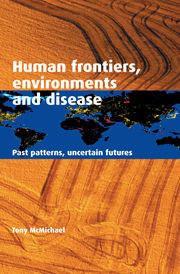Book contents
- Frontmatter
- Contents
- List of sources for illustrations
- Preface
- 1 Disease patterns in human biohistory
- 2 Human biology: the Pleistocene inheritance
- 3 Adapting to diversity: climate, food and infection
- 4 Infectious disease: humans and microbes coevolving
- 5 The Third Horseman: food, farming and famines
- 6 The industrial era: the Fifth Horseman?
- 7 Longer lives and lower birth rates
- 8 Modern affluence: lands of milk and honey
- 9 Cities, social environments and synapses
- 10 Global environmental change: overstepping limits
- 11 Health and disease: an ecological perspective
- 12 Footprints to the future: treading less heavily
- Notes
- Index
5 - The Third Horseman: food, farming and famines
Published online by Cambridge University Press: 05 March 2012
- Frontmatter
- Contents
- List of sources for illustrations
- Preface
- 1 Disease patterns in human biohistory
- 2 Human biology: the Pleistocene inheritance
- 3 Adapting to diversity: climate, food and infection
- 4 Infectious disease: humans and microbes coevolving
- 5 The Third Horseman: food, farming and famines
- 6 The industrial era: the Fifth Horseman?
- 7 Longer lives and lower birth rates
- 8 Modern affluence: lands of milk and honey
- 9 Cities, social environments and synapses
- 10 Global environmental change: overstepping limits
- 11 Health and disease: an ecological perspective
- 12 Footprints to the future: treading less heavily
- Notes
- Index
Summary
The biblical Third Horseman of the Apocalypse, Famine, rides a black horse. Humankind has had long familiarity with that horseman. The Bible recounts how Joseph, leader of the enslaved Israelites in Middle Kingdom Egypt, foresaw for Pharaoh the seven years of drought and famine, symbolised in Pharoah's dream as seven lean cattle. Egypt was ever hostage to the annual rhythms of the Nile and the flood-borne silt that fertilised the fields of the river plain. Indeed, the Old Kingdom, ruled by godlike Pharoahs and adorned with pyramids, had collapsed around 2200 BC because of climatic vicissitudes that caused prolonged droughts, reductions in river flow and serious famine. The same regional drought contributed to the collapse of the Akkadian Empire in Mesopotamia and the Harrapan civilisation of the Indus Valley. A thousand years later, the rulers of Egypt's Middle Kingdom were more alert to the need to manage flood control and conserve agricultural resources, and less disposed to think of themselves as infallible gods on Earth. Even so, there was little practical advice that Joseph could give Pharaoh, other than to store the surplus corn from the seven good years. There was no other way to lessen the impending climatic disaster.
The more usual historical situation has been that famine has struck unbuffered populations, with few food reserves. As in all of nature, human populations tend to increase in size to the limit of the local environment's ‘carrying capacity’.
- Type
- Chapter
- Information
- Human Frontiers, Environments and DiseasePast Patterns, Uncertain Futures, pp. 123 - 151Publisher: Cambridge University PressPrint publication year: 2001



